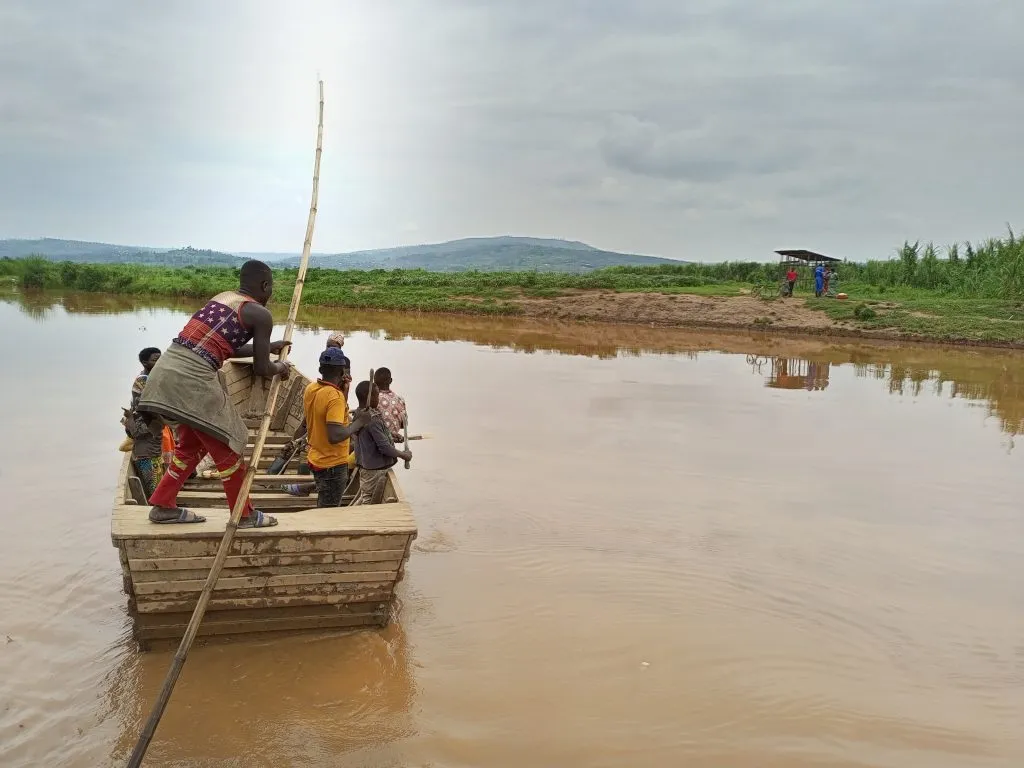Exploring Akanyaru River Rwanda
Exploring Akanyaru River Rwanda: The Akanyaru River flows east and north along the border between Rwanda and Burundi, where it joins the Nyabarongo River. It then forms the Akagera River, which flows towards Lake Victoria and the source of the Nile. The Akanyaru River is a significant headwater, rising to a height of 2,450 meters in Burundi. Its source is located in the southern region of Rwanda, around 2,300 meters. The river’s upstream section is covered in papyrus and contains a seasonal swamp forest. The river has a catchment area of roughly 2,650 km2.

Unprotected wetlands encircle the River Akanyura, which spans an area of roughly 2,650 square kilometers and has a width of about 7 kilometers when it meets the Nyabarongo River. The 14,600 hectares of permanent swamps on the Burundian side of the swamp are fed by the rivers Cyohoha North and Cyohoha South. This equates to approximately 63 kilometers of the river’s length, where the swamp extends 6 to 10 kilometers up to the valleys of tributaries.
The average annual rainfall in the river basin’s upstream portion is approximately 1200 mm, whereas the yearly rainfall in the wetland area is roughly 800 mm. Rwanda experiences two distinct rainy seasons annually, one from March to May and the other from mid-September to mid-December.
There are several different types of marshy ecosystems including papyrus swamps around the River Akanyaru. Leersia hexandra, Pistia stratiotes, and Oryza barthii are the floating vegetation that inhabits the river’s early succession phases. Miscanthidium Violaceum, Typha australis, Cladium jamaicense, and papyrus plants are combined to form the transitional phases. Among others, Typha australis, Cyperus denudatus, Miscanthidum, Cyperus, and Echinochloa Pyramidalis predominate in more complicated and developed ecosystems. In addition, there are sizable wetlands that are either entirely composed of stands of plants or mixed with shrubs. About 800 millimeters of rain fall on average each year in the Akanyaru marshes.
The marshland is home to a large number of bird species, including migratory and globally threatened species like the Papyrus yellow warbler, the Papyrus gonolek, the Madagascar squacco herons, the lesser swamp warbler, the great snipe, the Pallid Harrier, and the lesser Kestrel. There are about 60 bird species that inhabit the marsh region. In addition, three Afro-tropical Highland biomes, one species of the Guinea-Congo Forest Biome, and over eleven species of Lake Victoria Biome birds can be found in the River Akanyura.
The area is cultivated since the Akanyaru River is not protected, especially in the valley.The locals fish in the rivers and wetlands all the time. Wetlands are utilized for farming and habitation. The local people destroys the habitats by cutting and burning March plants during the dry season.

Additional activities available on the Rwandan wildlife safari at Akanyaru River include as follows:
Observing birds near the River Akanyaru Wetland With over 54 different species of aquatic and marsh birds calling the Akanyaru wetlands home, they are one of Rwanda‘s Important Bird Paradise sites. A few of these incredible bird species, which include the lesser swamp warbler, the great snipe, the Pallid Harrier, the lesser Kestrel, the Madagascar squacco herons, and the Papyrus yellow warbler, will be visible to you.
Discover the Papyrus and Marshy Environments; a global safari can easily set you up with wonderful walks across the Papyrus and Marshy Environments. Swamps abound around the shallow ends of the Akanyaru River, providing ideal habitat for a variety of wildlife species. A variety of marshy ecosystems and papyrus swamps define the wetlands. You will come across several stages of vegetation as you explore, ranging from early succession phases with floating vegetation (like Oryza barthii, Pistia stratiotes, and Leersia hexandra) to more complex habitats where Typha australis, Cyperus denudatus, and Echinochloa Pyramidalis are dominant. Enjoy a leisurely stroll through these distinct habitats to see the variety of plants and animals.
In order to have an amazing adventure safari in the Akanyaru River, you must travel with a certified local guide who is extremely informed about the local bird species. You should bring a camera, binoculars, long pants and long shirts to protect yourself from any vegetation, sturdy hiking boots that are waterproof because you’ll be trekking through wetland areas, enough of drinking water to stay hydrated, and lastly Among other things, heed the advice of your local guide and show consideration for the environment.
The ideal time to go to Rwanda‘s Akanyaru River
The dry season is the ideal time to visit the Akanyaru River. While it is possible to go bird watching at Akanyaru River all year round, certain months offer better birding circumstances than others. There are two main rainy and dry seasons in Rwanda. It is said that the months of December through January are ideal for birdwatching safaris. These months, which are unique since multitudes of migrating birds enter the nation to avoid the severe winters in Europe and the Arctic, fall within the dry season.
Generally speaking, the River Akanyaru offers a wide variety of experiences and activities, starting with exhilarating bird viewing. Because of their distinct attractiveness, River Akanyaru is the ideal place for travelers looking for both peace and adventure. Therefore, make sure to explore this gorgeous river and take in the natural wonders of Rwanda while you come. Whatever your interests—wildlife lovers, thrill-seekers, or those just seeking a quiet getaway—the River Akanyaru has something unique in store for you. Come explore the splendor of these undiscovered treasures and make lifelong memories.
